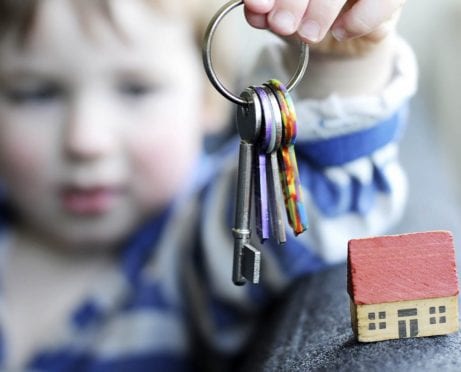
Do you remember many of your firsts — your first date, your first drive, your first day at a new school? Those first moments and actions are some of the most powerful rites of passages in our lives. They symbolize a fresh start, a new beginning, or the first sentence in a new chapter.
In January 2016, my husband and I said goodbye to the Chicago skyscrapers and hello to an entirely different world, a place filled with cowboys, blue skies, and wide open spaces. We said hello to Wyoming.
Opportunity was calling our name. My husband received a great job offer, and it seemed logical to move to a cheaper location while we paid off our debt.
The required annual income for a single adult in Wyoming is $27,425 before taxes, according to the Massachusetts Institute of Technology. This means the cost of living in Wyoming is 5 percent lower than the national average, whereas Chicago’s is 23 percent higher.
Every Dollar Counts
Saving while relocating meant taking on more client work and sacrificing little things like emotional shopping and checking bags on our flight.
We pulled through the move by budgeting.
Every expense was accounted for and documented. I used paper methods, spreadsheets, and journals to track the bills that were flowing in and the money that was owed to us. Budgeting by any means possible was a survival tactic from us going back on our first goal.
My husband and I set a goal of paying off $20,001 by the end of the year. In the month of January, the first month of the year, we managed to pay down $3,000 worth of that debt. Now, that’s a first of which I am proud.
The Cash Payback Method
February is supposed to be this month of love. We celebrate it by turning everything into red hearts and pink flowers. We write love letters to our crushes and listen to romantic melodies — Frank Sinatra’s tunes are my personal favorite. We generally spend the month going the extra mile for the ones we love.
But I spent that February less like Cupid shooting arrows into bare bottoms and more like a warrior on a warpath. And enemy number one was our debt.
Among the most frequent pieces of advice I got when I first started focusing on my debt a few years ago was the cash-only method. The theory is great: You cash your paychecks and use only that money to pay your bills.
At the end of the month, you put whatever you have left over toward your debts. It required a lot of advance planning and just sucked the energy out of us. But if you want strategies like this one to work, you must fully commit.
Credit Card Debt Repayment
I picked our smallest debt, a credit card we rarely use, and I chewed it bit by bit. Anytime I had an extra dollar, I threw it at the debt. I did this so much that my husband became annoyed at how many emails he would get confirming each payment — $5 here, $28 there, always with different amounts.
I’m proud that I was able to make $3,624 of debt payment in the shortest month of the year, bringing us that much closer to our goal of paying off $20,001 by the year’s end. That’s a total that I would have thought impossible just a few months earlier.
But I managed to pull it off by doing it — as Sinatra sings — my way.
The Rule of Three: Debt Setbacks
The month of April was all disasters. And the “Rule of Three” was the enemy this time around.
Three terrible things have to happen before it gets better. It’s the “when it rains, it pours” situation that almost each and every one of us knows so well.
For my family, the “Rule of Three” isn’t just superstition. It’s reality. Much of our current debt revolves around three bad things happening before we can recover.
For example, we experienced my pregnancy and hospitalization, a Cesarean section that kept me from working, and three NICU/PICU visits for our baby during the first three months of her life. Those three bad things were both pricey and painful.
What happened next was pricey for me, and painful for my car. Long story short, I am learning that my new state of Wyoming doesn’t take very good care of their highways during snowy weather, and my poor little car ended up in a ditch with a busted bumper. Talk about setbacks toward our debt repayment goals.
Contingency Funds Count When Paying Off Debt
Just over two-thirds (64 percent) of Americans have enough saved to access $400 for an emergency without borrowing money or selling something they own, according to the Federal Reserve Bank.
Staying in that group is more important to my husband and me than paying off our debt. Being prepared for the next round of “Three” is a bigger priority than the chance to finally kill a credit card.
That meant, for the month of April, our official debt payback total came out to $600 (all pre-car disaster), which brought us to a total of $12,067 paid back and $7,934 to go.
Calculating Opportunity Cost
If debt repayment were as simple as reading a book, taking a course, or paying for an expert to handle our finances, Americans wouldn’t have an average of $92,727 in debt weighing them down, according to a recent Experian study.
Part of the reason it’s so difficult to stay straight on that path to debt repayment is because that path doesn’t exist.
Let me give you an example: Back in early April 2016, I was given the opportunity of a lifetime to attend the Democratic National Convention in Philadelphia. And as someone who is politically minded and aspires to run for office, it was a dream come true to be handed credentials and a spot to attend.
I think you can guess the flipside of this. Attending such a convention is 100 percent self-funded — an estimated $4,000 to $5,000 for the four-day event.
But as my dad said, “It’s not every day you get the chance to do the thing you most want in life. You better take the good chances when they come to you. It’s not that hard to see that.”
Taking this opportunity meant putting our debt repayment plans on hold while I saved for the trip. It also meant giving up our family vacation in September that we were about to book and tapping into a small holidays/gift savings account.
We still managed to pay down $457 that May, which brought us to a total of $12,521 paid toward our goal of $20,001. That left us with $7,480 to go.
Managing Windfall Profits
When I looked back at our major debt repayment over the first half of the year, I noticed one trend: Each month came with a substantial cash windfall — a sudden unexpected influx of money. For us, that was the return of our security deposit for our Chicago apartment in February as well as our tax refund in March.
Each amount went straight toward our debt without even visiting our bank account for more than 24 hours. We couldn’t stand the temptation.
Paying off a large overall goal doesn’t have to be a ton of work, but it does take sacrifice and persistence. And if you come out on track, it gives you a great high. I felt like we were closer to the summit, having climbed to $13,271.
Controlling Summer Spending
Sunshine, blue skies, fluffy beach towels… the last thing I wanted to think about that summer was debt. But debt doesn’t go away just because the temperature goes up. It’s always there rearing its ugly head to remind me that a summer of freedom isn’t free.
It’s hard to write out a confession like this, especially when I talk about good money sense all day long. But as much as it pains me, I also think it’s important to address the elephant in the room and the weight on my shoulders: We weren’t that great with our money that summer.
For example, I spent $8 on a souvenir book for my daughter that I couldn’t say no to (though I knew better) and $35 on dinner with a friend who I hadn’t seen in ages. There were $40 trips to get my nails done. There were $30 dresses that I actually didn’t need for an event.
And those “little things,” as I call them, turn into one big problem after another. Mainly, they come back as debt.
It would have been easy for me to beat myself up over the new debt, but I didn’t. Instead, I used the end of July as a springboard for the next five months. It started with restocking our emergency fund back to $1,200 by using savings from the platforms Ellevest and Acorns.
Once I felt more secure with our money, I made decided to try repaying debt with $1,251 toward killing off one of our two credit cards. I’d held onto that small debt for what seemed like ages. That card now lives in a locked box.
Then I paid off the majority of our new summer debt, including an insane dental bill. That was a total of $1,925. While I went back and forth on whether to do so, I decided to include this in my total, since debt is debt. It doesn’t matter when or why you got into it.
That brought us to a grand total of $16,447 paid off with $3,554 left to go.
The Road to Debt Elimination
At the time, one of my favorite sports teams was going through a period that many sportscasters call a “rebuilding year.” If you’re not up on your sports terminology, that’s a transition period in which, after a season or more of performing poorly, the team makes massive changes.
Though this is good for the team in the long run, it usually means having a season or two where everyone struggles to get it together under the new culture. I like to think that the first year in Wyoming was a sort of “transition year” for my family.
We rewrote our entire playbook and fought back urges to replace “nothingness” with “somethingness.” That meant saying “no” a lot: no to shopping, no to eating out, and no to extensive traveling just because we were bored and had a little extra money.
The Bottom Line on Debt Repayment
By September, my husband and I had only $1,918 toward debt repayment with several months still left in the year. So we spent time rethinking our goal and deciding how we should prioritize our debt repayment.
The vast majority of our successes came thanks to the lessons we picked up along the way (putting aside nearly half of our income, focusing on small frugality, and taking on side hustles when possible).
What also worked for us was our new location. Now, I’m not saying that everyone should get up right now and move to Middle-of-Nowhere, U.S.A. But not having a Target around the block means that I had fewer opportunities to go shopping for things that I really didn’t need.
Those first months were more difficult than I like to admit, and there were many instances when I didn’t think I could successfully continue the journey. We made it through by learning to be comfortable with living through a transition year and embracing the obstacles of trying new things.
With time, my husband and I learned to love a new kind of life that focuses on saving so that we can build a better tomorrow.








![[VIDEO] Debt Payoff Methods: Snowball vs Avalanche](https://centsai.com/wp-content/uploads/2021/06/Debt-Payoff-Methods-Snowball-vs-Avalanche-461x372.jpg)
![[INFOGRAPHIC] How Americans Are Handling Debt](https://centsai.com/wp-content/uploads/2021/04/Infographic-How-Americans-Are-Handling-Debt-461x372.jpg)

